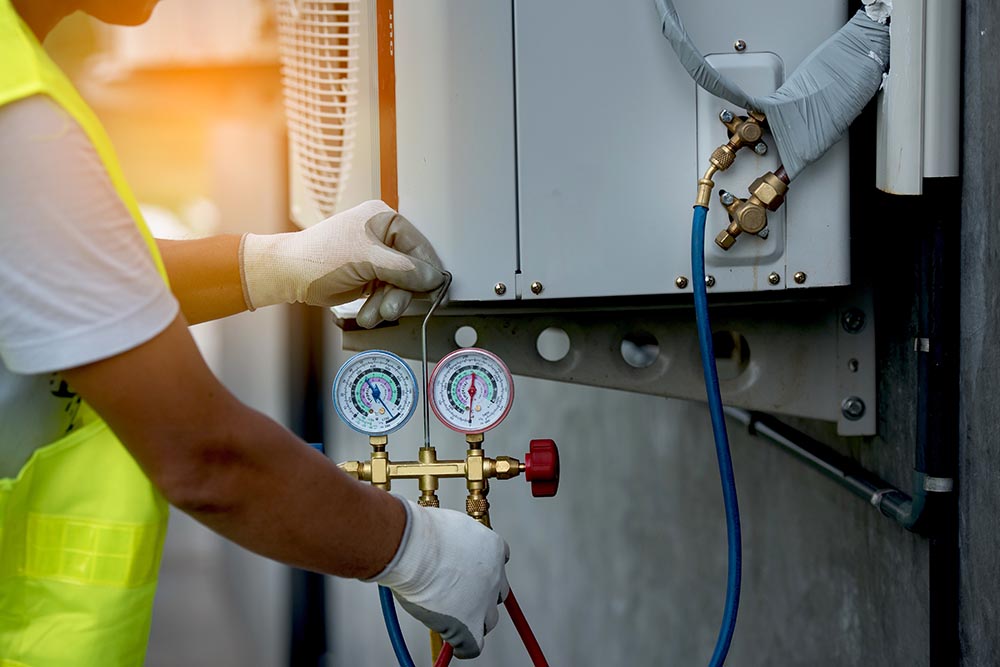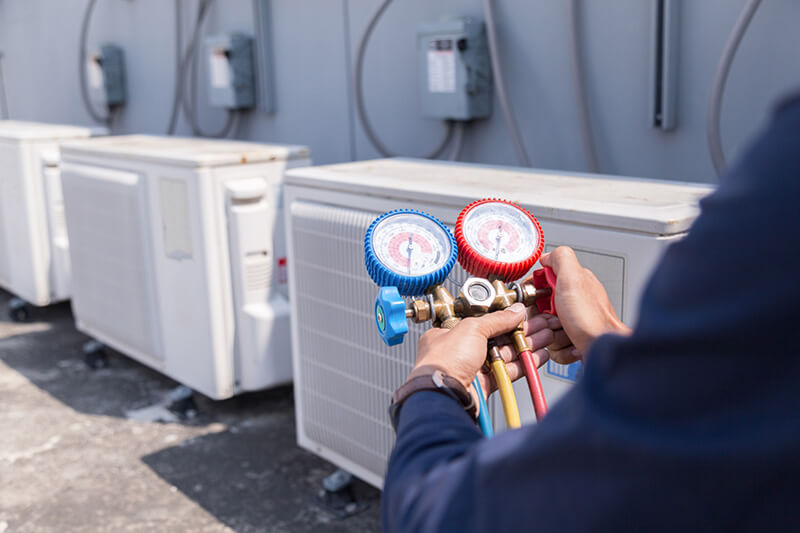Avoid Costly Repairs with Scheduled heat pump service
Avoid Costly Repairs with Scheduled heat pump service
Blog Article
How a Warmth Pump and Heating System Work Together to Enhance Your Home's Heating Performance
Recognizing how a warmth pump and furnace job together is vital for property owners seeking reliable home heating remedies. Each system has its toughness, providing a balanced strategy to home convenience. The heatpump masters moderate temperature levels, while the heater delivers quick warmth throughout extreme cold. This harmony not only lowers energy expenses but likewise boosts the life expectancy of both home appliances. What elements affect this collaboration, and exactly how can house owners maximize their advantages?
Recognizing Warmth Pumps: Exactly How They Function
Several people might be strange with their inner operations, warm pumps play a necessary function in modern-day home heating systems. These devices operate by moving heat from one area to an additional, utilizing the concepts of thermodynamics. In cooler months, a heat pump essences warm from the outdoors air, ground, or water, and transfers it indoors to warm the space. Conversely, throughout warmer months, it can reverse the procedure, serving as an a/c by expelling warmth from inside to the outside.Heat pumps include an evaporator, compressor, development, and condenser shutoff. The cooling agent within the system absorbs warmth as it vaporizes at reduced temperatures and stress. The compressor after that boosts the stress and temperature of the refrigerant, allowing it to release warmth as it condenses. This effective procedure can substantially minimize energy usage compared to standard heating methods, making warmth pumps a sustainable choice for environment control in homes.
The Duty of Heaters in Home Heating
Heaters play a crucial function in home heating by giving a trusted source of heat during the chillier months. They operate by generating heat through combustion or electric resistance, dispersing it throughout the home by means of air ducts or glowing systems. The performance of a heating system is usually determined by its Annual Fuel Application Efficiency (AFUE) rating, which suggests how effectively the system converts fuel into heat.Furnaces can use numerous power resources, including gas, lp, electricity, or oil, allowing house owners to choose one of the most appropriate alternative for their requirements. Unlike warmth pumps, which might struggle in extreme cold, heaters preserve consistent efficiency, guaranteeing that interior temperatures continue to be comfortable no matter of outdoor problems. Furthermore, modern-day heating systems often come outfitted with advanced innovation, such as variable-speed blowers and smart thermostats, boosting their efficiency and responsiveness. This flexibility makes furnaces a vital component in all-encompassing home heating approaches.

Advantages of Utilizing Both Solutions Together
Integrating the staminas of both furnaces and heatpump can lead to a more efficient and effective home heating solution. Using both systems enables house owners to benefit from the heatpump's energy efficiency throughout milder temperatures while relying upon the furnace for even more extreme cold problems. This twin technique can substantially lower power costs, as warmth pumps consume much less electrical energy than conventional home heating techniques when temperatures are moderate.Additionally, making use of both systems together can boost comfort degrees in the home. Heatpump can provide consistent, also heating, while furnaces can promptly increase ambient temperature levels when needed. In addition, the combination of both systems can expand the life expectancy of tools by decreasing wear and tear on each system, as they share the workload. Inevitably, property owners can appreciate a well balanced, cost-effective heating remedy that readjusts effortlessly to differing climate condition, ensuring a cozy and welcoming home throughout the cold weather.
Exactly How Warmth Pumps and Furnaces Enhance Each Various Other
They create a corresponding heating system that takes full advantage of effectiveness and convenience when home owners integrate warm pumps and heating systems. Warm pumps run by transferring warm from the outside air or ground, making them extremely reliable in moderate climates. They stand out during milder temperatures, providing cost-effective home heating. Conversely, heating systems produce warm through combustion or electrical resistance, delivering solid, immediate warmth during extreme cold conditions.The combination of these two systems enables for dynamic modifications based on temperature level changes. During warmer months or milder winter months days, the heatpump can take the lead, saving energy and decreasing expenses. As temperatures drop, the furnace can seamlessly engage, ensuring regular heat throughout the home. This harmony not only optimizes power usage but additionally boosts the life expectancy of both systems, as each device operates within its perfect performance array. With each other, they produce a balanced setting that adapts to varying climate needs.
Enhancing Efficiency: Tips for Homeowners
Home owners can boost their home heating effectiveness through numerous functional approaches. Establishing a routine maintenance routine, integrating clever thermostat modern technology, and executing effective insulation and sealing services are vital steps. These measures not just enhance convenience yet likewise reduce power expenses.
Regular Upkeep Arrange
To ensure maximum home heating effectiveness, establishing a normal maintenance routine is vital for any home. Homeowners must focus on routine evaluations of both warm pumps and furnaces to identify peak performance. This includes transforming air filters every one to three months, as clogged up filters can greatly lower performance. In addition, scheduling specialist upkeep at the very least yearly enables specialists to recognize and resolve potential problems prior to they escalate. House owners need to also clean up the warm pump's exterior device to stop debris buildup that can hinder air movement. By sticking to a normal upkeep routine, homeowners not only enhance their heating unit' performance however additionally extend their life expectancy, leading to greater comfort and minimized power costs throughout the cooler months.
Smart Thermostat Assimilation
Incorporating a smart thermostat right into a home heater can considerably enhance energy efficiency, specifically as it enables for accurate control over temperature settings. These gadgets can discover the homeowner's schedule and preferences, automatically readjusting the temperature level to optimize comfort while minimizing power use. They can reduce home heating during times when the home is vacant, decreasing unneeded intake. Numerous smart thermostats likewise offer real-time energy use information, making it possible for home owners to make educated choices about their heating behaviors. Furthermore, remote accessibility by means of smartphone applications her latest blog allows customers to adjust settings from anywhere, making sure the home is cozy upon return. On the whole, smart thermostat combination not only boosts comfort however considerably adds to power savings and effectiveness.
Insulation and Securing Solutions
Smart thermostats play a crucial function in power efficiency, however their efficiency can be greatly improved by correct insulation and sealing options. House owners should prioritize protecting floorings, walls, and attic rooms to reduce warmth loss. High-quality insulation products, such as spray foam or fiberglass, can significantly boost thermal resistance. Additionally, sealing gaps around ducts, doors, and home windows stops cold air infiltration and warmth retreat. Weatherstripping and caulking work techniques for attending to these leakages - heat pump replacement ooltewah tn. Regular examinations important link for air leakages, together with the use of blower door tests, can assist identify problem locations. By buying insulation and sealing, property owners can optimize the performance of their furnace, eventually bring about lowered power intake and reduced energy expenses
Common Misconceptions Regarding Heat Pumps and Furnaces
What misconceptions surround heatpump and furnaces? Many people erroneously think that warm pumps are inadequate in cooler environments. In truth, modern-day warmth pumps are developed to operate successfully even in reduced temperature levels, supplying reliable home heating throughout winter months. Another common misconception is that heating systems are constantly more efficient than warmth pumps. Nonetheless, this relies on the specific power sources and performance scores of the devices in concern. Some may also think that making use of both systems all at once is unnecessary, yet in truth, this combination can enhance heating performance, specifically during severe weather condition problems. Additionally, people commonly assume that warm pumps call for continuous upkeep, when actually, they have comparable upkeep needs to traditional home heating systems. By debunking these myths, home owners can make even more enlightened decisions concerning their home heating options, inevitably resulting in improved comfort and power efficiency in their homes.
Maintenance Factors To Consider for Combined Solutions

Regularly Asked Inquiries
Can Warmth Pumps Work Effectively in Exceptionally Cold Climates?
Heatpump can battle in extremely cool climates because of lowered efficiency and warm extraction restrictions. Developments in technology have led to models designed for far better efficiency in such problems, improving their feasibility in extreme atmospheres.
Exactly How Lengthy Do Warm Pumps and Furnaces Commonly Last?
Warmth pumps typically last 15 to twenty years, while heaters have a life-span of 15 to thirty years. Routine maintenance can extend their long life, ensuring efficient procedure and decreasing the requirement for premature replacements.

What Is the Average Expense of Installing Both Systems?
The ordinary cost of mounting both a heatpump and a furnace generally varies between $5,000 to $10,000 - ductless mini splits. Aspects influencing this price include system dimension, installment complexity, and local labor rates
Exist Tax Obligation Incentives for Making Use Of Energy-Efficient Heating Equipments?
Several property owners make inquiries about tax obligation motivations for energy-efficient furnace. Numerous federal and state programs commonly offer rebates or credit ratings, motivating the fostering of lasting modern technologies to reduce power intake and advertise environmental obligation.
Just how Do I Pick the Right Dimension Warmth Pump and Furnace?
Choosing the right size warmth pump and heater entails computing the home's square video, thinking about insulation high quality, and examining local climate. Consulting an expert can ensure suitable system efficiency and energy performance based upon particular needs. furnace replacement. Comprehending exactly how a heat pump and heater work with each other is vital for house owners looking for effective heating solutions. In chillier months, a warm pump extracts heat from the outdoors air, ground, or water, and transfers it inside your home to warm the living space. When homeowners incorporate warmth pumps and heating systems, they develop a corresponding home heating system that maximizes performance and convenience. Warmth pumps run by moving heat from the outdoors air or ground, making them highly reliable in modest climates. Warm pumps can have a hard time in incredibly cold environments due to minimized efficiency and warm extraction constraints
Report this page